+ データを開く
データを開く
- 基本情報
基本情報
| 登録情報 | データベース: PDB / ID: 5zdz | ||||||
|---|---|---|---|---|---|---|---|
| タイトル | Hairpin Forming Complex, RAG1/2-Nicked 12RSS/23RSS complex in Ca2+ | ||||||
 要素 要素 |
| ||||||
 キーワード キーワード | DNA BINDING PROTEIN / V(D)J recombination / RAG1-2-12RSS-23RSS complex / Hairpin forming complex | ||||||
| 機能・相同性 |  機能・相同性情報 機能・相同性情報Apoptosis induced DNA fragmentation / open form four-way junction DNA binding / calcium-dependent protein kinase regulator activity / positive regulation of myeloid progenitor cell differentiation / crossed form four-way junction DNA binding / Pyroptosis / Advanced glycosylation endproduct receptor signaling / plasmacytoid dendritic cell activation / regulation of tolerance induction / Regulation of TLR by endogenous ligand ...Apoptosis induced DNA fragmentation / open form four-way junction DNA binding / calcium-dependent protein kinase regulator activity / positive regulation of myeloid progenitor cell differentiation / crossed form four-way junction DNA binding / Pyroptosis / Advanced glycosylation endproduct receptor signaling / plasmacytoid dendritic cell activation / regulation of tolerance induction / Regulation of TLR by endogenous ligand / regulation of T cell mediated immune response to tumor cell / positive regulation of myeloid cell differentiation / myeloid dendritic cell activation / positive regulation of toll-like receptor 2 signaling pathway / mature B cell differentiation involved in immune response / TRAF6 mediated NF-kB activation / positive regulation of toll-like receptor 9 signaling pathway / B cell homeostatic proliferation / bent DNA binding / negative regulation of T cell differentiation in thymus / positive regulation of glycogen catabolic process / neutrophil clearance / TAK1-dependent IKK and NF-kappa-B activation / DN2 thymocyte differentiation / positive regulation of toll-like receptor 4 signaling pathway / DNA geometric change / pre-B cell allelic exclusion / endothelial cell chemotaxis / eye development / positive regulation of organ growth / regulation of behavioral fear response / bubble DNA binding / induction of positive chemotaxis / V(D)J recombination / myeloid cell differentiation / negative regulation of T cell apoptotic process / myeloid progenitor cell differentiation / phosphatidylinositol-3,4-bisphosphate binding / regulation of nucleotide-excision repair / macrophage activation involved in immune response / negative regulation of thymocyte apoptotic process / positive regulation of monocyte chemotactic protein-1 production / positive regulation of innate immune response / cellular response to interleukin-7 / endothelial cell proliferation / phosphatidylinositol-3,5-bisphosphate binding / glycogen catabolic process / apoptotic cell clearance / supercoiled DNA binding / DNA binding, bending / positive regulation of mesenchymal cell proliferation / positive regulation of T cell differentiation / regulation of T cell differentiation / organ growth / T cell lineage commitment / positive regulation of wound healing / B cell lineage commitment / phosphatidylserine binding / positive regulation of sprouting angiogenesis / endoplasmic reticulum-Golgi intermediate compartment / T cell homeostasis / phosphatidylinositol-3,4,5-trisphosphate binding / positive regulation of interferon-alpha production / protein kinase activator activity / T cell differentiation / response to glucocorticoid / four-way junction DNA binding / protein autoubiquitination / positive regulation of autophagy / : / phosphatidylinositol-4,5-bisphosphate binding / Neutrophil degranulation / phosphatidylinositol binding / positive regulation of mitotic cell cycle / B cell differentiation / positive regulation of interferon-beta production / thymus development / positive regulation of interleukin-1 beta production / cytokine activity / lung development / positive regulation of non-canonical NF-kappaB signal transduction / visual learning / base-excision repair / RING-type E3 ubiquitin transferase / autophagy / positive regulation of interleukin-6 production / ubiquitin-protein transferase activity / positive regulation of tumor necrosis factor production / ubiquitin protein ligase activity / double-strand break repair / heparin binding / double-stranded RNA binding / chromatin organization / chromosome / T cell differentiation in thymus / cellular response to lipopolysaccharide / double-stranded DNA binding / endonuclease activity / DNA recombination / adaptive immune response 類似検索 - 分子機能 | ||||||
| 生物種 |  synthetic construct (人工物) | ||||||
| 手法 |  X線回折 / X線回折 /  シンクロトロン / シンクロトロン /  分子置換 / 解像度: 2.8 Å 分子置換 / 解像度: 2.8 Å | ||||||
 データ登録者 データ登録者 | Kim, M.S. / Chuenchor, W. / Chen, X. / Gellert, M. / Yang, W. | ||||||
| 資金援助 |  米国, 1件 米国, 1件
| ||||||
 引用 引用 |  ジャーナル: Mol Cell / 年: 2018 ジャーナル: Mol Cell / 年: 2018タイトル: Cracking the DNA Code for V(D)J Recombination. 著者: Min-Sung Kim / Watchalee Chuenchor / Xuemin Chen / Yanxiang Cui / Xing Zhang / Z Hong Zhou / Martin Gellert / Wei Yang /    要旨: To initiate V(D)J recombination for generating the adaptive immune response of vertebrates, RAG1/2 recombinase cleaves DNA at a pair of recombination signal sequences, the 12- and 23-RSS. We have ...To initiate V(D)J recombination for generating the adaptive immune response of vertebrates, RAG1/2 recombinase cleaves DNA at a pair of recombination signal sequences, the 12- and 23-RSS. We have determined crystal and cryo-EM structures of RAG1/2 with DNA in the pre-reaction and hairpin-forming complexes up to 2.75 Å resolution. Both protein and DNA exhibit structural plasticity and undergo dramatic conformational changes. Coding-flank DNAs extensively rotate, shift, and deform for nicking and hairpin formation. Two intertwined RAG1 subunits crisscross four times between the asymmetric pair of severely bent 12/23-RSS DNAs. Location-sensitive bending of 60° and 150° in 12- and 23-RSS spacers, respectively, must occur for RAG1/2 to capture the nonamers and pair the heptamers for symmetric double-strand breakage. DNA pairing is thus sequence-context dependent and structure specific, which partly explains the "beyond 12/23" restriction. Finally, catalysis in crystallo reveals the process of DNA hairpin formation and its stabilization by interleaved base stacking. | ||||||
| 履歴 |
|
- 構造の表示
構造の表示
| 構造ビューア | 分子:  Molmil Molmil Jmol/JSmol Jmol/JSmol |
|---|
- ダウンロードとリンク
ダウンロードとリンク
- ダウンロード
ダウンロード
| PDBx/mmCIF形式 |  5zdz.cif.gz 5zdz.cif.gz | 535.7 KB | 表示 |  PDBx/mmCIF形式 PDBx/mmCIF形式 |
|---|---|---|---|---|
| PDB形式 |  pdb5zdz.ent.gz pdb5zdz.ent.gz | 414.3 KB | 表示 |  PDB形式 PDB形式 |
| PDBx/mmJSON形式 |  5zdz.json.gz 5zdz.json.gz | ツリー表示 |  PDBx/mmJSON形式 PDBx/mmJSON形式 | |
| その他 |  その他のダウンロード その他のダウンロード |
-検証レポート
| 文書・要旨 |  5zdz_validation.pdf.gz 5zdz_validation.pdf.gz | 536.5 KB | 表示 |  wwPDB検証レポート wwPDB検証レポート |
|---|---|---|---|---|
| 文書・詳細版 |  5zdz_full_validation.pdf.gz 5zdz_full_validation.pdf.gz | 581 KB | 表示 | |
| XML形式データ |  5zdz_validation.xml.gz 5zdz_validation.xml.gz | 78.3 KB | 表示 | |
| CIF形式データ |  5zdz_validation.cif.gz 5zdz_validation.cif.gz | 108.8 KB | 表示 | |
| アーカイブディレクトリ |  https://data.pdbj.org/pub/pdb/validation_reports/zd/5zdz https://data.pdbj.org/pub/pdb/validation_reports/zd/5zdz ftp://data.pdbj.org/pub/pdb/validation_reports/zd/5zdz ftp://data.pdbj.org/pub/pdb/validation_reports/zd/5zdz | HTTPS FTP |
-関連構造データ
- リンク
リンク
- 集合体
集合体
| 登録構造単位 | 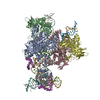
| ||||||||
|---|---|---|---|---|---|---|---|---|---|
| 1 | 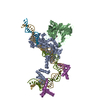
| ||||||||
| 2 | 
| ||||||||
| 単位格子 |
|
- 要素
要素
-タンパク質 , 3種, 5分子 ACBDN
| #1: タンパク質 | 分子量: 71871.305 Da / 分子数: 2 / 断片: UNP residues 384-1008 / 由来タイプ: 組換発現 / 由来: (組換発現)   Homo sapiens (ヒト) Homo sapiens (ヒト)参照: UniProt: P15919, 加水分解酵素; エステル加水分解酵素, RING-type E3 ubiquitin transferase #2: タンパク質 | 分子量: 43225.711 Da / 分子数: 2 / 断片: UNP residues 1-387 / Mutation: M1V / 由来タイプ: 組換発現 / 由来: (組換発現)   Homo sapiens (ヒト) / 参照: UniProt: P21784 Homo sapiens (ヒト) / 参照: UniProt: P21784#3: タンパク質 | | 分子量: 18897.885 Da / 分子数: 1 / 断片: UNP residues 1-163 / 由来タイプ: 組換発現 / 由来: (組換発現)   |
|---|
-DNA鎖 , 6種, 6分子 FIJGLM
| #4: DNA鎖 | 分子量: 13978.961 Da / 分子数: 1 / 由来タイプ: 合成 / 由来: (合成) synthetic construct (人工物) |
|---|---|
| #5: DNA鎖 | 分子量: 4864.165 Da / 分子数: 1 / 由来タイプ: 合成 / 由来: (合成) synthetic construct (人工物) |
| #6: DNA鎖 | 分子量: 4855.150 Da / 分子数: 1 / 由来タイプ: 合成 / 由来: (合成) synthetic construct (人工物) |
| #7: DNA鎖 | 分子量: 16640.654 Da / 分子数: 1 / 由来タイプ: 合成 / 由来: (合成) synthetic construct (人工物) |
| #8: DNA鎖 | 分子量: 9138.938 Da / 分子数: 1 / 由来タイプ: 合成 / 由来: (合成) synthetic construct (人工物) |
| #9: DNA鎖 | 分子量: 12036.805 Da / 分子数: 1 / 由来タイプ: 合成 / 由来: (合成) synthetic construct (人工物) |
-非ポリマー , 5種, 137分子 

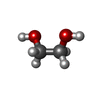






| #10: 化合物 | | #11: 化合物 | #12: 化合物 | #13: 化合物 | #14: 水 | ChemComp-HOH / | |
|---|
-実験情報
-実験
| 実験 | 手法:  X線回折 / 使用した結晶の数: 1 X線回折 / 使用した結晶の数: 1 |
|---|
- 試料調製
試料調製
| 結晶 | マシュー密度: 3.49 Å3/Da / 溶媒含有率: 64.79 % 解説: THE ENTRY CONTAINS FRIEDEL PAIRS IN F_PLUS/MINUS COLUMNS. |
|---|---|
| 結晶化 | 温度: 277 K / 手法: 蒸気拡散法, ハンギングドロップ法 詳細: 100mM MES (pH 6.8), 15% PEG 3350, 200mM Potassium formate |
-データ収集
| 回折 | 平均測定温度: 100 K |
|---|---|
| 放射光源 | 由来:  シンクロトロン / サイト: シンクロトロン / サイト:  APS APS  / ビームライン: 22-ID / 波長: 1 Å / ビームライン: 22-ID / 波長: 1 Å |
| 検出器 | タイプ: MARMOSAIC 300 mm CCD / 検出器: CCD / 日付: 2016年8月20日 |
| 放射 | プロトコル: SINGLE WAVELENGTH / 単色(M)・ラウエ(L): M / 散乱光タイプ: x-ray |
| 放射波長 | 波長: 1 Å / 相対比: 1 |
| 反射 | 解像度: 2.8→50 Å / Num. obs: 198942 / % possible obs: 99.6 % / 冗長度: 4.1 % / Net I/σ(I): 14.5 |
| 反射 シェル | 解像度: 2.8→2.9 Å |
- 解析
解析
| ソフトウェア |
| |||||||||||||||||||||||||||||||||||||||||||||||||||||||||||||||||||||||||||||||||||||||||||||||||||||||||||||||||||||||||||||||||||||||||||||||||||||||||||||||||||||||||||||||||||||||||||||||||||||||||||||||||||||||||
|---|---|---|---|---|---|---|---|---|---|---|---|---|---|---|---|---|---|---|---|---|---|---|---|---|---|---|---|---|---|---|---|---|---|---|---|---|---|---|---|---|---|---|---|---|---|---|---|---|---|---|---|---|---|---|---|---|---|---|---|---|---|---|---|---|---|---|---|---|---|---|---|---|---|---|---|---|---|---|---|---|---|---|---|---|---|---|---|---|---|---|---|---|---|---|---|---|---|---|---|---|---|---|---|---|---|---|---|---|---|---|---|---|---|---|---|---|---|---|---|---|---|---|---|---|---|---|---|---|---|---|---|---|---|---|---|---|---|---|---|---|---|---|---|---|---|---|---|---|---|---|---|---|---|---|---|---|---|---|---|---|---|---|---|---|---|---|---|---|---|---|---|---|---|---|---|---|---|---|---|---|---|---|---|---|---|---|---|---|---|---|---|---|---|---|---|---|---|---|---|---|---|---|---|---|---|---|---|---|---|---|---|---|---|---|---|---|---|---|
| 精密化 | 構造決定の手法:  分子置換 / 解像度: 2.8→43.719 Å / SU ML: 0.4 / 交差検証法: FREE R-VALUE / σ(F): 1.35 / 位相誤差: 27.76 分子置換 / 解像度: 2.8→43.719 Å / SU ML: 0.4 / 交差検証法: FREE R-VALUE / σ(F): 1.35 / 位相誤差: 27.76 詳細: SF FILE CONTAINS FRIEDEL PAIRS UNDER I/F_MINUS AND I/F_PLUS COLUMNS.
| |||||||||||||||||||||||||||||||||||||||||||||||||||||||||||||||||||||||||||||||||||||||||||||||||||||||||||||||||||||||||||||||||||||||||||||||||||||||||||||||||||||||||||||||||||||||||||||||||||||||||||||||||||||||||
| 溶媒の処理 | 減衰半径: 0.9 Å / VDWプローブ半径: 1.11 Å | |||||||||||||||||||||||||||||||||||||||||||||||||||||||||||||||||||||||||||||||||||||||||||||||||||||||||||||||||||||||||||||||||||||||||||||||||||||||||||||||||||||||||||||||||||||||||||||||||||||||||||||||||||||||||
| 精密化ステップ | サイクル: LAST / 解像度: 2.8→43.719 Å
| |||||||||||||||||||||||||||||||||||||||||||||||||||||||||||||||||||||||||||||||||||||||||||||||||||||||||||||||||||||||||||||||||||||||||||||||||||||||||||||||||||||||||||||||||||||||||||||||||||||||||||||||||||||||||
| 拘束条件 |
| |||||||||||||||||||||||||||||||||||||||||||||||||||||||||||||||||||||||||||||||||||||||||||||||||||||||||||||||||||||||||||||||||||||||||||||||||||||||||||||||||||||||||||||||||||||||||||||||||||||||||||||||||||||||||
| LS精密化 シェル |
|
 ムービー
ムービー コントローラー
コントローラー





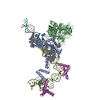










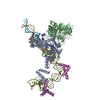
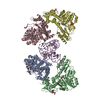
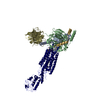
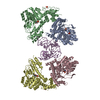


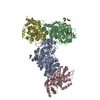
 PDBj
PDBj





















































